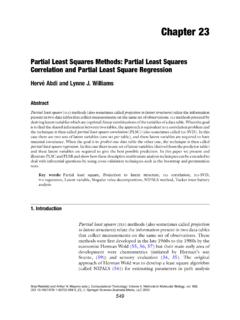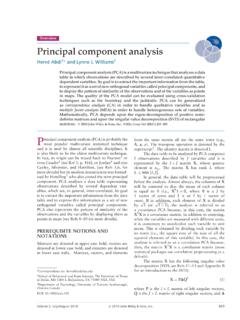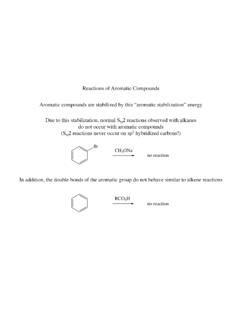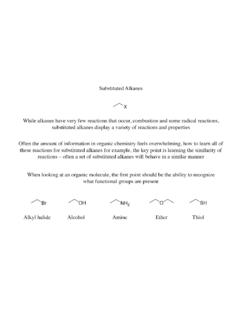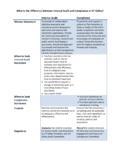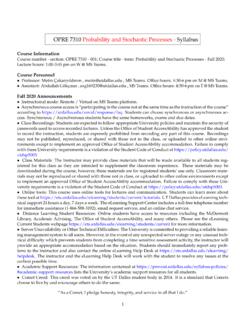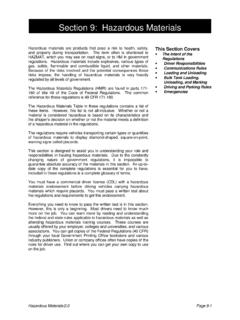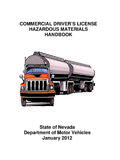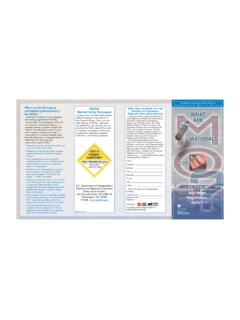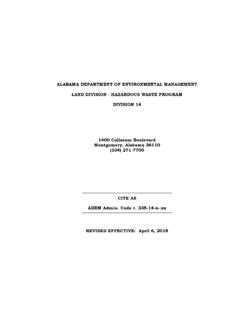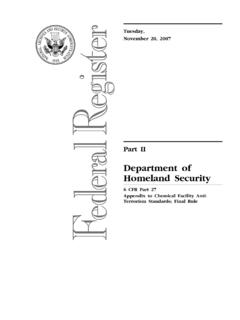Transcription of Chemical and Hazardous Materials Safety
1 Chemical and Hazardous Materials Safety Department of Environmental Health and Safety 800 West Campbell Rd., SG10 Richardson, TX 75080-3021 Phone 972-883-2381/4111 Fax 972-883-6115 Modified: April 2012 2 INTRODUCTION The purpose of the Chemical Safety Section is to provide information useful in the recognition, evaluation, and control of workplace hazards and environmental factors existing within and/or associated with the laboratories of the University. Almost everyone works with or around chemicals and Chemical products every day. Chemical Safety is inherently linked to other Safety issues including engineering controls, laboratory procedures, personal protective equipment, electrical Safety , fire Safety , and Hazardous waste disposal. Many chemicals have properties that make them Hazardous : they can represent physical hazards (fire, explosion) and/or health hazards (toxicity, Chemical burns, and dangerous fumes). However, there are many ways to work with chemicals which can both reduce the probability of an accident and minimize the consequences should an accident occur.
2 Risk minimization depends on safe practices, appropriate engineering controls for Chemical containment, the proper use of personal protective equipment, the use of the minimum quantity of material necessary, and/or substitution of less Hazardous chemicals. Before beginning an operation, one should ask "What would happen if ..?" The answer to this question requires an understanding of the hazards associated with the chemicals, equipment and procedures involved. The Hazardous properties of the material and its intended use will dictate the precautions to be taken. It is important to distinguish the difference between hazard and risk. The two terms are sometimes used as synonyms. In fact, the term hazard is a much more complex concept because it includes conditions of use. The hazard presented by a Chemical has two components: (1) its inherent capacity to do harm by virtue of its toxicity, flammability, explosiveness, corrosiveness, etc.; and (2) the ease with which the Chemical can come into contact with a person or other object of concern.
3 The two components together determine risk the likelihood or probability that a harmful consequence will occur. Thus, an extremely toxic Chemical such as strychnine cannot cause poisoning if it is in a sealed container and does not contact the handler. In contrast, a Chemical that is not highly toxic can be lethal if a large amount is ingested. It should be noted that not all chemicals are considered Hazardous . Examples of nonhazardous chemicals include pH neutral buffers, sugars, starches, agar, and naturally occurring amino acids. This chapter will focus on Hazardous chemicals. This section is not intended to be an exhaustive reference, but rather, a guide to assist investigators, laboratory managers, and other technically qualified individuals. Further advice concerning the hazards associated with specific substances may be obtained from The Office of Environmental Health and Safety or from your supervisor. Each program shall provide a supplement to this Chemical Safety Section which addresses specific hazards in its program area.
4 A copy of this supplement should be provided to the Office of Environmental Health and Safety , which will provide it to the local fire department and other emergency responders as appropriate. 3 The University Radiation Safety Section should be consulted for specific Safety information concerning radioactive Materials and/or radiation producing devices. Chemical Safety GUIDELINES Always follow these guidelines when working with chemicals: a. Assume that any unfamiliar Chemical is Hazardous and treat it as such. b. Know all the hazards of the chemicals with which you work. For example, perchloric acid is a corrosive, an oxidizer, and a reactive. Benzene is an irritant that is also flammable, toxic, and carcinogenic. c. Never underestimate the potential hazard of any Chemical or combination of chemicals. Consider any mixture or reaction product to be at least as Hazardous as if not more Hazardous than its most Hazardous component. d. Never use any substance that is not properly labeled.
5 It may not be what you think it is! e. Date all chemicals when they are received and again when they are opened. f. Follow all Chemical Safety instructions, such as those listed in material Safety Data Sheets or on Chemical container labels, precisely. g. Minimize your exposure to any Chemical , regardless of its hazard rating, and avoid repeated exposure. h. Use personal protective equipment (PPE), as appropriate for that Chemical . i. Use the buddy system when working with Hazardous chemicals. Don t work in the laboratory alone. material Safety DATA SHEETS Before using any Chemical , read the appropriate material Safety Data Sheet (MSDS). An MSDS is a document that details information about chemicals and along with the container label is a good source of information for Chemical Safety . It provides the following information: a. Identity of the Chemical b. The manufacturer s name and address c. Hazardous ingredients d. Exposure limits 4 i.
6 Permissible Exposure Limit (PEL) or Recommended Exposure Limit (REL) This is the amount of a Chemical that a person can be exposed to, averaged over an eight hour period, before it causes him/her harm. ii. Short Term Exposure Limit (STEL) This is the amount of a Chemical that a person can be exposed to, averaged over a 15 minute period, before it causes him/her harm. iii. Immediately Dangerous to Life and Health (IDLH) This is the amount of Chemical that immediately puts a person a risk of serious injury or death. If this level is reach or exceeded, the area should be evacuated immediately! e. Physical characteristics, such as: i. Boiling point ii. Vapor pressure f. Chemical hazards, including the following: i. Flammability ii. Explosiveness iii. Reactivity g. Health hazards, including chemicals that are: 1) Toxins (both acute and long-term) 2) Carcinogens 3) Reproductive Toxins 4) Teratogens 5) Mutagens 6) Neurotoxins ii.
7 Irritants 6) Routes of Entry 7) Emergency and first-aid procedures 8) Proper leak, spill, and disposal techniques 9) Proper storage and handling procedures l. Other special provisions Each person working with chemicals should have access to the MSDS for all chemicals they use. Access may be: -A current hard copy kept in a work area file or binder. -An electronic copy. TYPES OF Chemical HAZARDS CORROSIVES 5 Corrosive chemicals destroy or damage living tissue by direct contact. Some acids, bases, dehydrating agents, oxidizing agents, and organics are corrosives. Examples of the different types of corrosive chemicals are listed below: Acidic corrosives: -Inorganic Acids -Hydrochloric acid -Nitric Acid -Sulfuric acid -Organic Acids -Acetic Acid -Propionic acid Alkaline, or basic, corrosives: -Sodium hydroxide -Potassium hydroxide Corrosive dehydrating agents: -Phosphorous pentoxide -Calcium oxide Corrosive oxidizing agents: -Halogen gases -Hydrogen peroxide (concentrated) -Perchloric acid Organic corrosive: -Butylamine HEALTH CONSEQUENCES Extreme caution should be taken when handling corrosive chemicals, or severe injury may result.
8 A. Concentrated acids can cause painful and sometimes severe burns. B. Inorganic hydroxides can cause serious damage to skin tissues because a protective protein layer does not form. Even a dilute solution such as sodium or potassium hydroxide can attack skin by reacting with the fat tissues and forming a soapy, slick film. C. At first, skin contact with phenol may not be painful, but the exposed area may turn white due to the severe burn. Systemic poisoning may also result from dermal exposure. 6 D. Skin contact with low concentrations of hydrofluoric acid (HF) may not cause pain immediately but can still cause tissue damage if not treated properly. Higher concentrations of HF (50% or greater) can cause immediate, painful damage to tissues. SAFE HANDLING FOR CORROSIVES To ensure safe handling of corrosives, the following special handling procedures should be used: A. Always store corrosives properly. Segregate acids from bases and inorganics from organics.
9 Refer to the Chemical Storage section of this chapter for more information. B. Always wear a laboratory coat, gloves and Chemical splash goggles when working with corrosives. Wear other personal protective equipment, as appropriate. C. To dilute acids, carefully add the acid to the water, not the water to the acid. This will minimize any reaction. D. Corrosives, especially inorganic bases ( , sodium hydroxide), may be very slippery; handle these chemicals with care and clean any spills, leaks, splashes, or dribbles immediately. E. Work in a Chemical fume hood when handling fuming acids or volatile irritants ( , ammonium hydroxide). F. A continuous flow eye wash station should be in every work area where corrosives are present. An emergency shower should also be within 55 feet of the area. ACID HANDLING Safety I. PURPOSE The importance of using acids in the laboratories throughout the University should not overshadow the inherent hazards and the possible damaging effects of acids for personnel working with acids.
10 Therefore, this procedure will indicate some of the most predominant hazards and the procedures that should be followed to avoid physical impairment. II. HAZARDS The hazards of acid are many. Some of the common hazards are: A. Acids, in liquid and vapor states, are highly toxic and irritating to the eyes, skin, and respiratory tract. B. Contact of acid with skin causes very painful and medically serious burns. C. Liquid contact with the eyes can cause immediate blindness. D. Some acids offer a fire and explosion hazard. 7 III. PROCEDURES A. Store strong acids separately and away from volatile organic chemicals. Do not store more than chest high. Close fitting, shatterproof containers shall be available for transporting glass containers of acids. B. Wear a face shield, acid resistant Chemical gloves, and aprons when working with acids. Emergency flood showers and/or eye wash fountains must be available. C. Dilute acids by stirring the concentrated acid slowly into the water.


